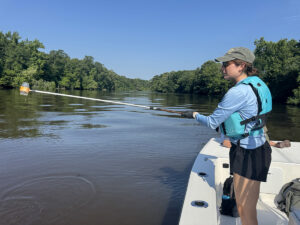News
Flooding of Blounts Creek with Martin Marietta’s Mine Wastewater before N.C. Supreme Court
Posted on July 2nd, 2020
Press Release from the Southern Environmental Law Center
For Release: July 2, 2020
Contacts:
Kathleen Sullivan, SELC, 919-945-7106 or ksullivan@selcnc.org
Flooding of Blounts Creek with Martin Marietta’s Mine Wastewater before N.C. Supreme Court
CHAPEL HILL, N.C.— On behalf of Sound Rivers and the North Carolina Coastal Federation, the Southern Environmental Law Center today filed a petition with the North Carolina Supreme Court arguing that a state permit failed to protect the waters of a popular fishing creek in eastern North Carolina, Blounts Creek, from Martin Marietta’s plan to discharge up to 12 millions of gallons of mine wastewater a day into the creek and flood it.
“The state permit fails to uphold the core requirement of the Clean Water Act: to protect our waters as they exist naturally,” said Geoff Gisler, senior attorney at the Southern Environmental Law Center. “Blounts Creek deserves the full protection that the law provides.”
Martin Marietta’s mine discharge would transform the swampy, slow moving headwater habitat into a fast-flowing stream consisting primarily of mine wastewater, permanently altering the creek’s diversity of fish and abundance of high quality fish habitat that make it a treasured fishing spot.
“Generations in Beaufort County have grown up fishing and boating on Blounts Creek,” said Heather Deck, executive director, Sound Rivers. “The natural diversity of life in Blounts Creek is beloved by the local community and many families across the state who want to ensure the creek is protected for future generations.”
Today’s filing follows a recent Court of Appeals of North Carolina decision that reversed an earlier state court decision to vacate the N.C. Division of Water Resources’ permit for the 649-acre open pit mine outside Vanceboro in Beaufort County, N.C. In 2017, Carteret County Superior Court found that the state permit failed to protect the biological integrity of the creek as required by state law.
“The fundamental requirements of our state and federal water quality laws require state agencies to protect the biological integrity, fish, and wildlife of our coastal creeks and sounds,” said Todd Miller, executive director of the N.C. Coastal Federation.
The creek provides vital habitat to a diverse community of fish—including red drum and river herring—and is beloved by locals and people across the state.
Martin Marietta admitted in its permit application that the altered creek would no longer support its existing diversity of fish species and would no longer be considered swamp waters due to the increased flow, increased pH, and other changes to the creek that would result from the discharge. DWR’s lead biologist found that the creek with the wastewater would be unlike any creek naturally found in eastern North Carolina. Under federal and state law, North Carolina cannot authorize discharges that will violate water quality standards by changing the natural mix of wildlife in a water body.
State wildlife agencies and the Environmental Protection Agency objected to the plan in their response to the draft state permit.
In violation of state and federal law and despite other agencies’ criticisms, the Division of Water Resources required no significant changes to address these problems in its final permit.
###
About the Southern Environmental Law Center
For more than 30 years, the Southern Environmental Law Center has used the power of the law to champion the environment of the Southeast. With more than 80 attorneys and nine offices across the region, SELC is widely recognized as the Southeast’s foremost environmental organization and regional leader. SELC works on a full range of environmental issues to protect our natural resources and the health and well-being of all the people in our region. www.SouthernEnvironment.org
About Sound Rivers
Sound Rivers was formed by the merger of the Neuse and Pamlico-Tar River Foundations on April 1, 2015 which combined two of the oldest conservation organizations in North Carolina. Sound Rivers continues the mission and purpose of both previous organizations, to monitor, protect and enhance the Neuse and Tar-Pamlico Rivers and watersheds. These watersheds cover more than 12,000 square miles and include the Pamlico Sound, a major component of the second largest estuary in the United States. Sound Rivers has three RIVERKEEPER®s who serve as investigators, advocates and educators for their watersheds, and it represents the interests of thousands of members and donors who live, visit or love this beautiful region of North Carolina. Sound Rivers and its members seek to ensure clean, safe water and an ecologically sound environment for today and for future generations to enjoy.
WEB: www.soundrivers.org
About the North Carolina Coastal Federation
The North Carolina Coastal Federation is the state’s only 501(c)(3) non-profit organization that focuses exclusively on protecting and restoring the coast of North Carolina through education, advocacy and habitat preservation and restoration.
WEB: www.nccoast.org
Related News

Specialist investigates lake connection to mysterious skin rash
July 10th 2025

Riverkeeper: Central NC flooding part of a much larger issue
July 10th 2025

N.C. Governor vetoes bad rulemaking bill
July 10th 2025

Riverkeeper, program director ‘Growing More than Rain Gardens’
July 10th 2025

Volunteer coordinator goes ‘fishing’
July 10th 2025

Neuse fish kill expected to extend beyond holiday weekend
July 3rd 2025

Swim Guide fails prompt Maple Cypress investigation
July 3rd 2025

Riverkeeper, town partners root out source of Smithfield sediment pollution
July 3rd 2025

